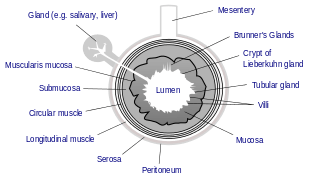Lumen (anatomy)
For other uses, see Lumen (disambiguation).

Cross section of the gut. The lumen is the space in the middle.
In biology, a lumen (from Latin lūmen, meaning "an opening"; plural lumina) is the inside space of a tubular structure, such as an artery or intestine.[1] By extension, the term lumen is also used to describe the inside space of a cellular component or structure, such as the endoplasmic reticulum.
- The interior of a vessel, such as the central space in an artery or vein through which blood flows.
- The interior of the gastrointestinal tract[2]
- The pathways of the bronchi in the lungs
- The interior of renal tubules and urinary collecting ducts
- The pathways of the female genital tract, starting with a single pathway of the vagina, splitting up in two lumina in the uterus, both of which continue through the fallopian tubes
- Within a cell, the inner membrane space of a thylakoid, endoplasmic reticulum, Golgi apparatus, lysosomes, mitochondria or microtubule.
Transluminal procedures
Transluminal procedures are procedures occurring through lumina, including:
- Natural orifice transluminal endoscopic surgery in the lumina of, for example the stomach, vagina, bladder or colon
- Percutaneous transluminal angioplasty in the lumina of blood vessels
See also
References
This article is issued from Wikipedia - version of the 11/22/2016. The text is available under the Creative Commons Attribution/Share Alike but additional terms may apply for the media files.